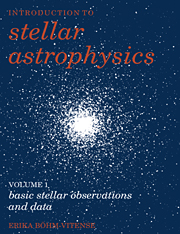Book contents
- Frontmatter
- Contents
- Preface
- 1 Positions of stars
- 2 Proper motions of stars
- 3 Distances of nearby stars
- 4 The brightnesses of the stars
- 5 Color magnitude diagrams
- 6 The luminosities of the stars
- 7 Angular radii of stars
- 8 Effective temperatures of stars
- 9 Masses and radii of stars
- 10 Spectral classification
- 11 Understanding stellar spectra
- 12 Population II stars
- 13 Stellar rotation
- 14 Stellar magnetic fields
- 15 Stars with peculiar spectra
- 16 Pulsating stars
- 17 Explosive stars
- 18 Our sun
- 19 Interstellar absorption
- Appendixes
- References
- Index
12 - Population II stars
Published online by Cambridge University Press: 04 August 2010
- Frontmatter
- Contents
- Preface
- 1 Positions of stars
- 2 Proper motions of stars
- 3 Distances of nearby stars
- 4 The brightnesses of the stars
- 5 Color magnitude diagrams
- 6 The luminosities of the stars
- 7 Angular radii of stars
- 8 Effective temperatures of stars
- 9 Masses and radii of stars
- 10 Spectral classification
- 11 Understanding stellar spectra
- 12 Population II stars
- 13 Stellar rotation
- 14 Stellar magnetic fields
- 15 Stars with peculiar spectra
- 16 Pulsating stars
- 17 Explosive stars
- 18 Our sun
- 19 Interstellar absorption
- Appendixes
- References
- Index
Summary
There are a few stars in our neighborhood whose spectra show a different chemical composition for their photospheres. These stars were previously known as subdwarfs. The reason for this name was their position in the color magnitude diagram: they appeared below the main sequence, which means they either are too faint for their color or they are too blue for their brightness. A spectrum analysis showed that the latter is the case. It turned out that, for these stars, the relative abundances of the heavy elements with respect to one another are quite similar to the ones observed for the sun, but the overall abundances of the heavy elements with respect to hydrogen and helium are considerably reduced by up to a factor of 500, though most of them have much smaller abundance reductions. In these metal-poor stars, the metallic lines are much weaker than for normal stars of the same temperature. Since spectral lines are generally stronger in the blue, and especially in the ultraviolet, than in the red, the lines take more energy out of the ultraviolet and blue spectral region than out of the red. If the lines are weakened in the metal-poor stars, more energy is restored to the ultraviolet and blue spectral region than in the red and the stars therefore look bluer, especially in the ultraviolet. They show an ultraviolet excess which can, in fact, be used to determine their metal deficiencies.
- Type
- Chapter
- Information
- Introduction to Stellar Astrophysics , pp. 107 - 110Publisher: Cambridge University PressPrint publication year: 1989

